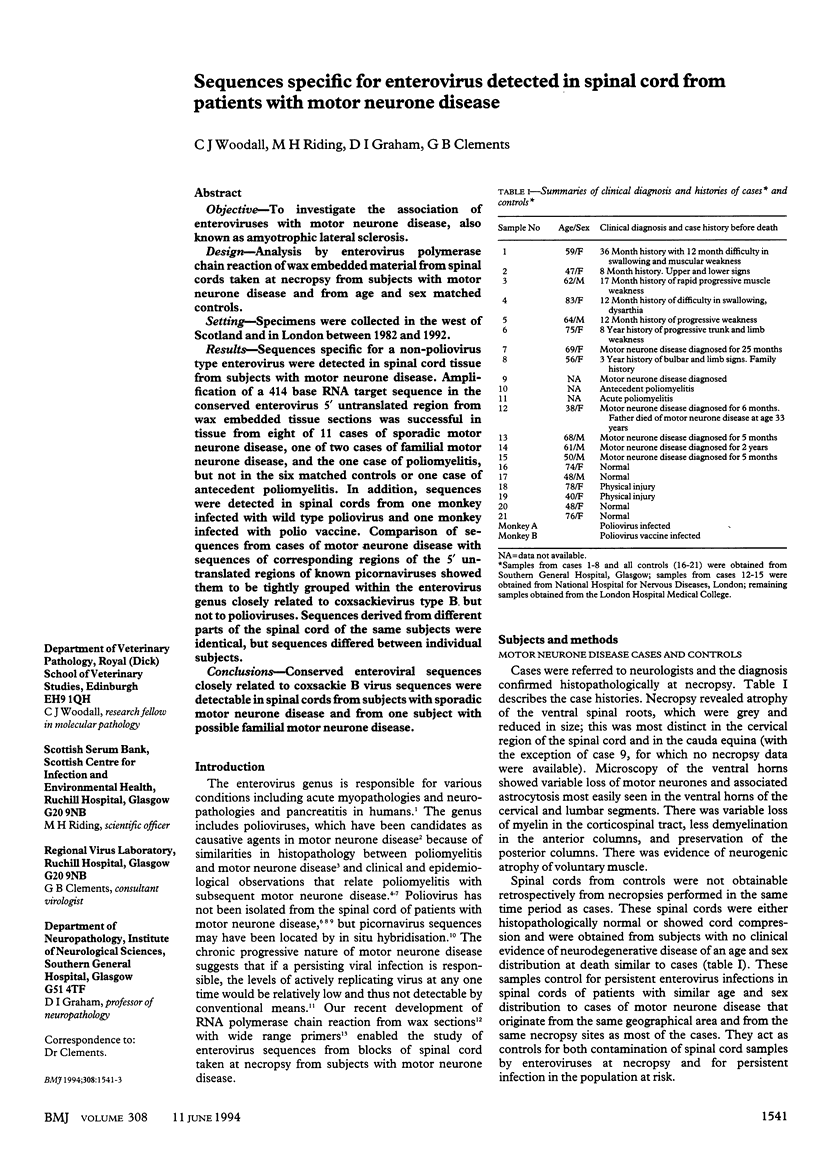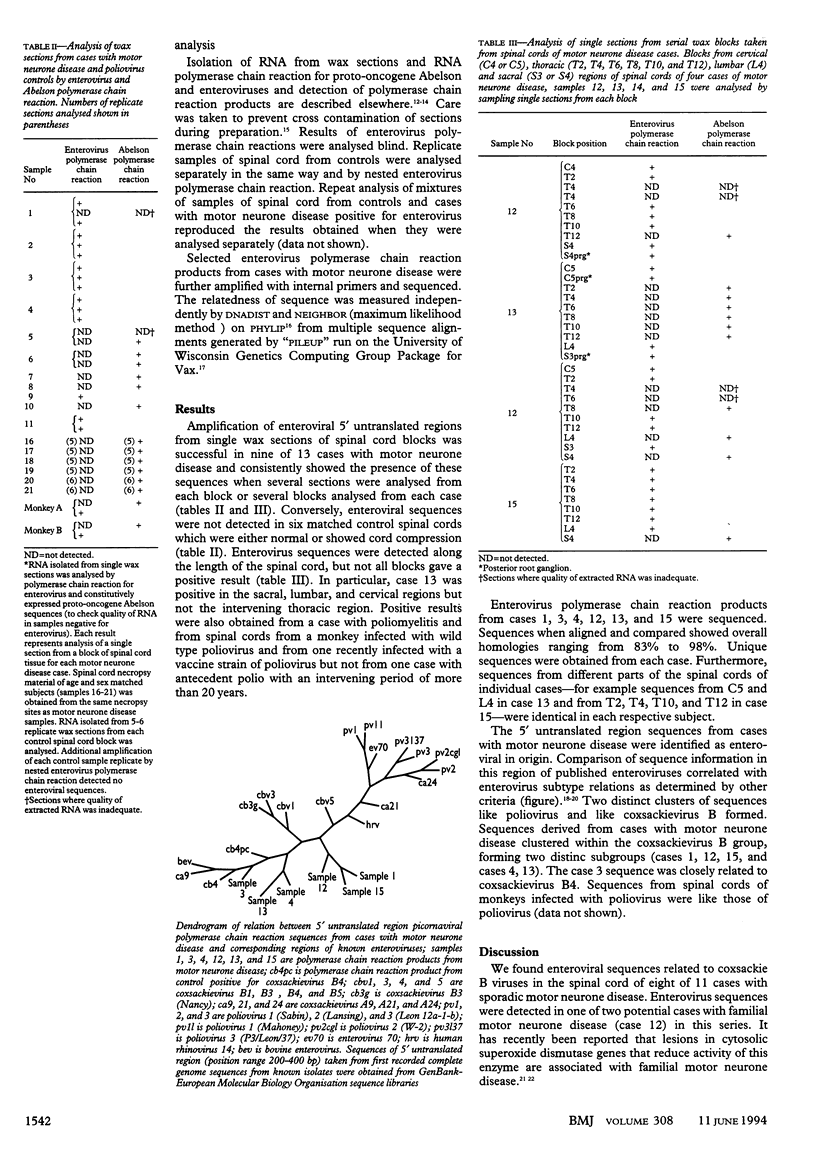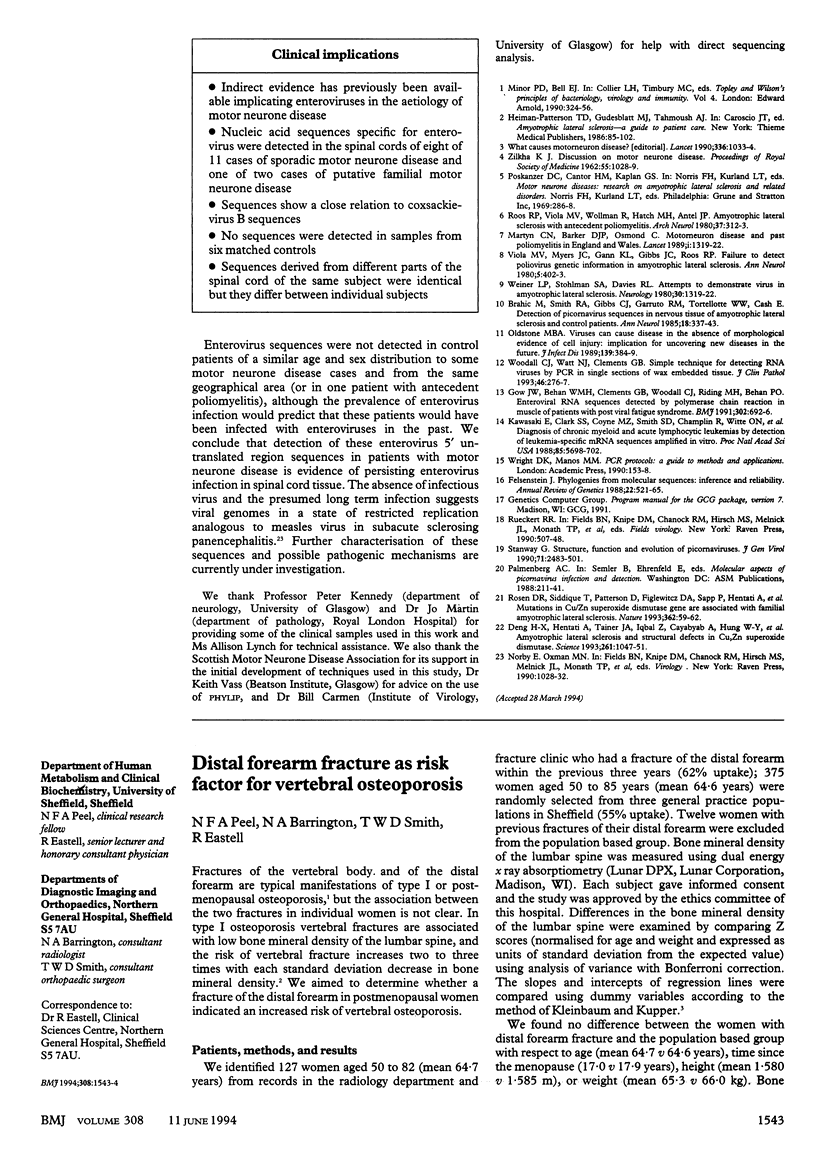Abstract
OBJECTIVE--To investigate the association of enteroviruses with motor neurone disease, also known as amyotrophic lateral sclerosis. DESIGN--Analysis by enterovirus polymerase chain reaction of wax embedded material from spinal cords taken at necropsy from subjects with motor neurone disease and from age and sex matched controls. SETTING--Specimens were collected in the west of Scotland and in London between 1982 and 1992. RESULTS--Sequences specific for a non-poliovirus type enterovirus were detected in spinal cord tissue from subjects with motor neurone disease. Amplification of a 414 base RNA target sequence in the conserved enterovirus 5' untranslated region from wax embedded tissue sections was successful in tissue from eight of 11 cases of sporadic motor neurone disease, one of two cases of familial motor neurone disease, and the one case of poliomyelitis, but not in the six matched controls or one case of antecedent poliomyelitis. In addition, sequences were detected in spinal cords from one monkey infected with wild type poliovirus and one monkey infected with polio vaccine. Comparison of sequences from cases of motor neurone disease with sequences of corresponding regions of the 5' untranslated regions of known picornaviruses showed them to be tightly grouped within the enterovirus genus closely related to coxsackievirus type B but not to polioviruses. Sequences derived from different parts of the spinal cord of the same subjects were identical, but sequences differed between individual subjects. CONCLUSIONS--Conserved enteroviral sequences closely related to coxsackie B virus sequences were detectable in spinal cords from subjects with sporadic motor neurone disease and from one subject with possible familial motor neurone disease.
Full text
PDF


Selected References
These references are in PubMed. This may not be the complete list of references from this article.
- Brahic M., Smith R. A., Gibbs C. J., Jr, Garruto R. M., Tourtellotte W. W., Cash E. Detection of picornavirus sequences in nervous tissue of amyotrophic lateral sclerosis and control patients. Ann Neurol. 1985 Sep;18(3):337–343. doi: 10.1002/ana.410180311. [DOI] [PubMed] [Google Scholar]
- Deng H. X., Hentati A., Tainer J. A., Iqbal Z., Cayabyab A., Hung W. Y., Getzoff E. D., Hu P., Herzfeldt B., Roos R. P. Amyotrophic lateral sclerosis and structural defects in Cu,Zn superoxide dismutase. Science. 1993 Aug 20;261(5124):1047–1051. doi: 10.1126/science.8351519. [DOI] [PubMed] [Google Scholar]
- Felsenstein J. Phylogenies from molecular sequences: inference and reliability. Annu Rev Genet. 1988;22:521–565. doi: 10.1146/annurev.ge.22.120188.002513. [DOI] [PubMed] [Google Scholar]
- Gow J. W., Behan W. M., Clements G. B., Woodall C., Riding M., Behan P. O. Enteroviral RNA sequences detected by polymerase chain reaction in muscle of patients with postviral fatigue syndrome. BMJ. 1991 Mar 23;302(6778):692–696. doi: 10.1136/bmj.302.6778.692. [DOI] [PMC free article] [PubMed] [Google Scholar]
- Kawasaki E. S., Clark S. S., Coyne M. Y., Smith S. D., Champlin R., Witte O. N., McCormick F. P. Diagnosis of chronic myeloid and acute lymphocytic leukemias by detection of leukemia-specific mRNA sequences amplified in vitro. Proc Natl Acad Sci U S A. 1988 Aug;85(15):5698–5702. doi: 10.1073/pnas.85.15.5698. [DOI] [PMC free article] [PubMed] [Google Scholar]
- Oldstone M. B. Viruses can cause disease in the absence of morphological evidence of cell injury: implication for uncovering new diseases in the future. J Infect Dis. 1989 Mar;159(3):384–389. doi: 10.1093/infdis/159.3.384. [DOI] [PubMed] [Google Scholar]
- Roos R. P., Viola M. V., Wollmann R., Hatch M. H., Antel J. P. Amyotrophic lateral sclerosis with antecedent poliomyelitis. Arch Neurol. 1980 May;37(5):312–313. doi: 10.1001/archneur.1980.00500540090016. [DOI] [PubMed] [Google Scholar]
- Rosen D. R., Siddique T., Patterson D., Figlewicz D. A., Sapp P., Hentati A., Donaldson D., Goto J., O'Regan J. P., Deng H. X. Mutations in Cu/Zn superoxide dismutase gene are associated with familial amyotrophic lateral sclerosis. Nature. 1993 Mar 4;362(6415):59–62. doi: 10.1038/362059a0. [DOI] [PubMed] [Google Scholar]
- Stanway G. Structure, function and evolution of picornaviruses. J Gen Virol. 1990 Nov;71(Pt 11):2483–2501. doi: 10.1099/0022-1317-71-11-2483. [DOI] [PubMed] [Google Scholar]
- Viola M. V., Myers J. C., Gann K. L., Gibbs J. C., Jr, Roos R. P. Failure to detect poliovirus genetic information in amyotrophic lateral sclerosis. Ann Neurol. 1979 Apr;5(4):402–403. doi: 10.1002/ana.410050419. [DOI] [PubMed] [Google Scholar]
- Weiner L. P., Stohlman S. A., Davis R. L. Attempts to demonstrate virus in amyotrophic lateral sclerosis. Neurology. 1980 Dec;30(12):1319–1322. doi: 10.1212/wnl.30.12.1319. [DOI] [PubMed] [Google Scholar]
- Woodall C. J., Watt N. J., Clements G. B. Simple technique for detecting RNA viruses by PCR in single sections of wax embedded tissue. J Clin Pathol. 1993 Mar;46(3):276–277. doi: 10.1136/jcp.46.3.276. [DOI] [PMC free article] [PubMed] [Google Scholar]
- ZILKHA K. J. Discussion on motor neurone disease. Proc R Soc Med. 1962 Dec;55:1028–1029. [PubMed] [Google Scholar]


